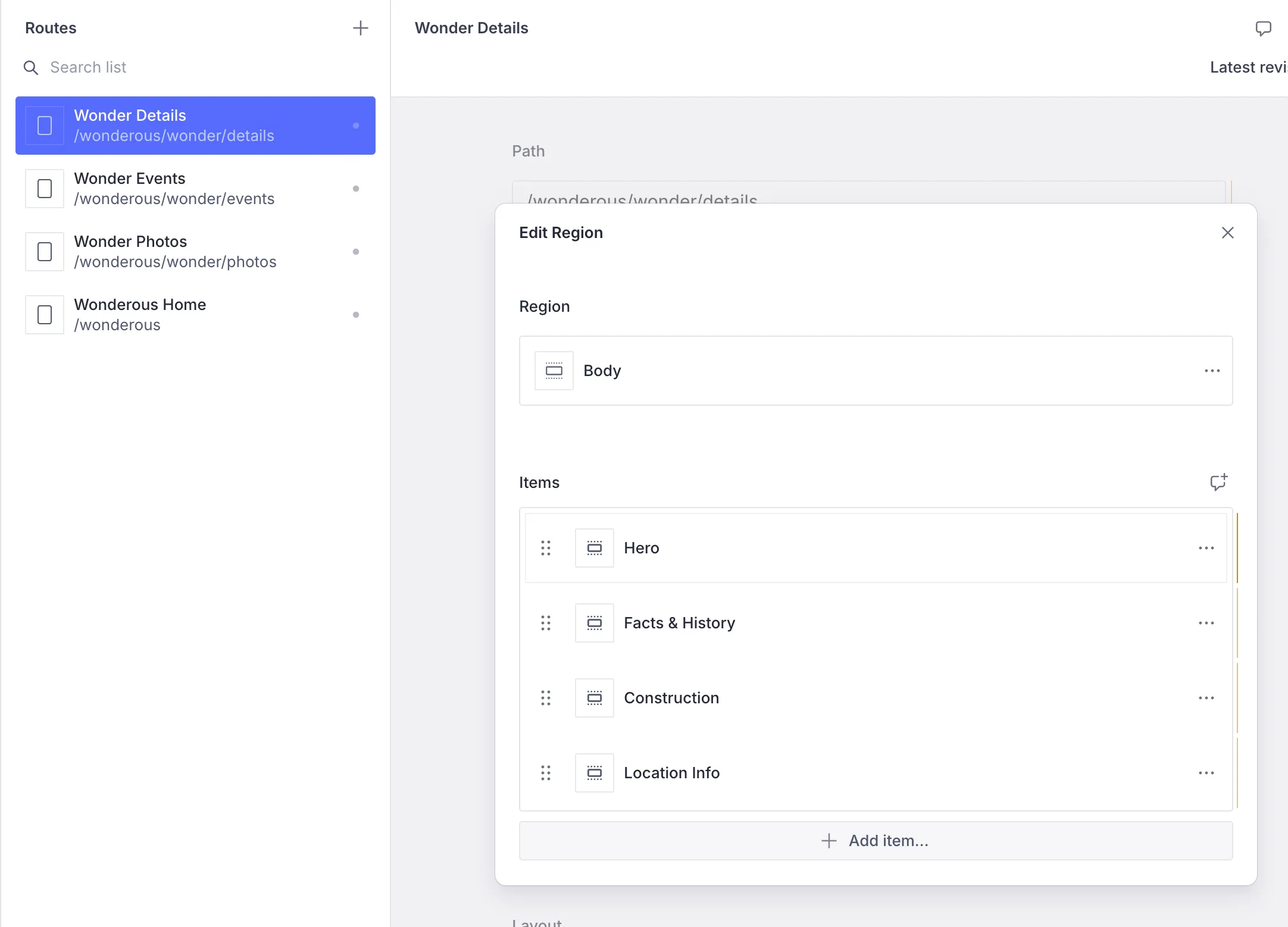Rendering a Wonder Section
Dividing the Wonder into a set of sections gives us some flexibility to play around with the layout of the Wonder on the screen. As we saw earlier, these sections can be changed on the CMS with the UI automatically reflecting it. Because these sections are just a type of Content Block, you could even add other kinds of Content Blocks in between, if needed.

The Flutter counterpart of a Wonder Section
Section titled “The Flutter counterpart of a Wonder Section”Defining the section on the CMS is only half the job. The other half lies in
creating a Flutter counterpart that can deserialize the json of the
wonder-section and render it using a Flutter Widget. This is managed by a custom
ContentBuilder for the WonderSection (a custom ContentItem).
We define this inside a FeatureDescriptor that represents the entire Wonderous
feature.
In the Vyuh Framework, a feature.dart represents one
logical feature of your application. Dividing your application into a set of
composable features allows us to build large scale apps with great benefits.
For our demo app, the entire Wonderous App has been represented as a feature,
with the FeatureDescriptor. This descriptor exposes the content items, layouts
and other aspects of a feature.
final feature = FeatureDescriptor( name: 'wonderous', title: 'Wonderous', description: 'The Wonderous app as a Vyuh Feature', icon: Icons.castle_outlined, init: () async { // initializes the API keys for Unsplash and loads other environment variables }, routes: routes, // The routes we saw in the earlier article extensions: [ ContentExtensionDescriptor( // Content builder for the WonderSection type contentBuilders: [ ContentBuilder<WonderSection>( content: WonderSection.typeDescriptor, defaultLayout: WonderSectionLayout(), defaultLayoutDescriptor: WonderSectionLayout.typeDescriptor, ), ], ) ]);And finally the WonderSection itself is shown below, which represents one
visual part of a Wonder. The WonderSectionLayout is the default layout that
knows how to render these sections, which you can see in the build() method.
Notice that all of this is completely type-safe and ensures you get the best developer-experience when dealing with CMS content.
import 'package:flutter/material.dart';import 'package:json_annotation/json_annotation.dart';import 'package:vyuh_core/vyuh_core.dart';
part 'section.g.dart';
@JsonSerializable()final class WonderSection extends ContentItem { static const schemaName = 'wonderous.wonder.section'; static final typeDescriptor = TypeDescriptor( schemaType: schemaName, title: 'Wonder Section', fromJson: WonderSection.fromJson, );
final String title; final WonderSectionType type;
WonderSection({ required this.title, required this.type, }) : super(schemaType: schemaName);
factory WonderSection.fromJson(Map<String, dynamic> json) => _$WonderSectionFromJson(json);}
enum WonderSectionType { hero, history, construction, locationInfo, events, photos,}
@JsonSerializable()final class WonderSectionLayout extends LayoutConfiguration<WonderSection> { static const schemaName = '${WonderSection.schemaName}.layout.default'; static final typeDescriptor = TypeDescriptor( schemaType: schemaName, title: 'Wonder Section Layout', fromJson: WonderSectionLayout.fromJson, );
WonderSectionLayout() : super(schemaType: schemaName);
factory WonderSectionLayout.fromJson(Map<String, dynamic> json) => _$WonderSectionLayoutFromJson(json);
@override Widget build(BuildContext context, WonderSection content) { return switch (content.type) { WonderSectionType.hero => const WonderHeroSection(), WonderSectionType.history => WonderHistorySection(title: content.title), WonderSectionType.construction => WonderConstructionSection(title: content.title), WonderSectionType.locationInfo => WonderLocationInfoSection(title: content.title), WonderSectionType.events => const WonderEventsSection(), WonderSectionType.photos => const WonderPhotosSection(), }; }}Notice how the WonderSection type mirrors the schema in TypeScript with the
same fields. As mentioned before, you get a type-safe version that you can
reliably use in your Flutter code.
Rendering a single WonderSection
Section titled “Rendering a single WonderSection”The previous code snippet shows how we render the various parts of the Wonder.
Each section fetches the Wonder document from the CMS and renders the parts
which are relevant. Instead of every section making parallel calls to fetch the
Wonder, we manage all of that inside the WonderSectionBuilder . This makes
use of a shared Future<Wonder> to ensure there are no duplicate network calls
to fetch the Wonder.
This is shown below. The shared future is inside the WonderClient, mapped to
the wonder’s identifier. This identifier is extracted from the
GoRouterState of the current route.
Once a wonder has been fetched, we delegate to the builder to do rest of the
rendering.
final class WonderSectionBuilder extends StatefulWidget { final Widget Function(BuildContext, Wonder) builder; const WonderSectionBuilder({super.key, required this.builder});
@override State<WonderSectionBuilder> createState() => _WonderSectionBuilderState();}
class _WonderSectionBuilderState extends State<WonderSectionBuilder> { ObservableFuture<Wonder?> _future = ObservableFuture.value(null);
@override void initState() { super.initState(); }
@override void didChangeDependencies() { super.didChangeDependencies();
final wonder = GoRouterState.of(context).pathParameters['wonder'] ?? '---'; _future = vyuh.di.get<WonderClient>().fetchWonder(wonder); }
@override Widget build(BuildContext context) { return Observer( builder: (context) { final status = _future.status; final wonder = _future.value;
switch (status) { case FutureStatus.pending: return vyuh.widgetBuilder.contentLoader(); case FutureStatus.rejected: return vyuh.widgetBuilder.errorView( title: 'Failed to fetch Wonder', error: _future.error); case FutureStatus.fulfilled: if (wonder == null) { return vyuh.widgetBuilder .errorView(title: 'Failed to fetch Wonder'); }
return Column( crossAxisAlignment: CrossAxisAlignment.stretch, children: [ widget.builder(context, wonder), const SectionDivider(), ], ); } }, ); }}Aside on fetching Wonders
Section titled “Aside on fetching Wonders”The WonderClient fetches the wonders from the Sanity CMS and deserializes to a
Dart type: Wonder. It also takes care of fetching photos from the Unsplash
collection.
Fetching the wonder from the CMS follows a simple query that looks up the wonder
by its identifier. Here is the fetchWonder() method of the WonderClient,
in its entirety.
final Map<String, ObservableFuture<Wonder?>> _wonderFutures = {};
ObservableFuture<Wonder?> fetchWonder(String id) { if (_wonderFutures.containsKey(id)) { return _wonderFutures[id]!; }
final wonderFuture = vyuh.content.provider.fetchSingle( '*[_type == "wonderous.wonder" && identifier == "$id"][0]', fromJson: Wonder.fromJson);
_wonderFutures[id] = ObservableFuture(wonderFuture);
return _wonderFutures[id]!; }Notice the use of the _wonderFutures cache to ensure only one network call
goes out for the Wonder.

